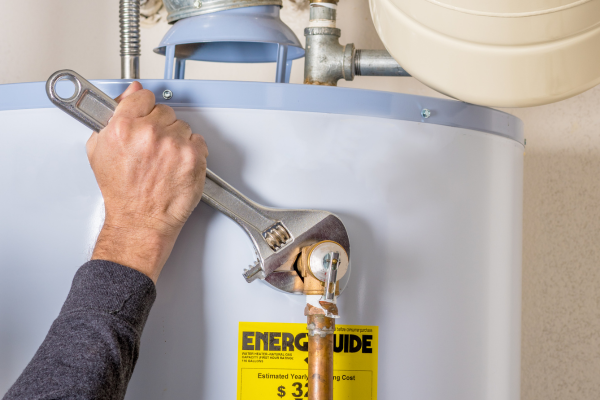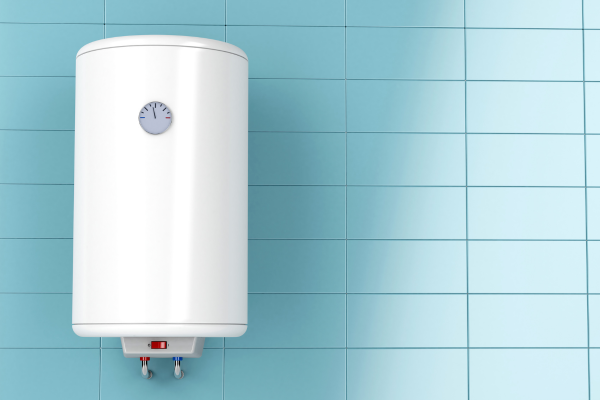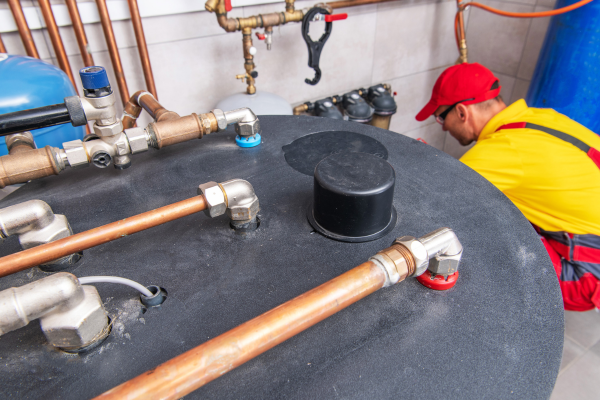When your hot water tank starts acting up, it can be frustrating. Not only is it an inconvenience, but it can also lead to higher energy bills, potential water damage, or an uncomfortable home environment. In such cases, the best solution might be a hot water tank replacement. But how do you know when it’s time to replace your hot water tank? And what should you expect during the replacement process?
At Pure Plumbing Solutions, we’re here to guide you through everything you need to know about hot water tank replacement. Whether you’re dealing with an aging tank, a sudden breakdown, or just looking to upgrade your current model, we have the experience and expertise to ensure the job is done right. In this blog post, we’ll cover the signs that indicate you need a replacement, how to choose the right tank, and the steps involved in installation and maintenance.
Signs That It’s Time for a Hot Water Tank
Before we get into the details of hot water tank replacement, let’s look at some of the common signs that your current tank may need replacing:
1. Age of the Hot Water Tank
Hot water tanks have a typical lifespan of 8 to 12 years. If your tank is approaching or has exceeded this age, it may be time to start thinking about replacement. As your hot water tank ages, it can become less efficient, leading to higher energy bills and frequent repairs.
2. Frequent Repairs
If you find yourself calling a plumber for repairs on a regular basis, it could be a sign that your tank is nearing the end of its useful life. Common issues like faulty thermostats, leaking valves, or broken heating elements might indicate that the tank’s internal components are failing.
3. Rusty or Discolored Water
Rusty or discolored water is often a sign that your hot water tank is deteriorating inside. When the tank starts to corrode, it can lead to leaks and poor water quality. If you notice reddish-brown water coming from your taps, this could be a warning sign that your tank is on its last legs.
4. Leaks Around the Tank
A leaking hot water tank is a serious issue that requires immediate attention. Over time, the steel tank can corrode, leading to leaks. If left unaddressed, this can result in water damage to your home and a much bigger repair job.
5. Inconsistent Water Temperature
If your hot water temperature fluctuates or if you experience long delays in getting hot water, this could indicate that the heating elements in your tank are failing. While this issue might be fixable with a repair, it could also be a sign that a replacement is needed.
6. No Hot Water Could Mean A Hot Water Tank Replacement
Of course, if you find that you’re no longer getting hot water, that’s a clear sign your tank isn’t working as it should. This can be caused by a faulty thermostat, heating elements, or an issue with the tank’s internal components.
If you’re experiencing any of these issues, it’s time to consider a hot water tank replacement. At Pure Plumbing Solutions, our expert team can help assess your situation and determine whether a replacement is the best solution.
You might be interested in: The Ultimate Emergency Plumbing Checklist

Choosing the Right Hot Water Tank for Your Home
Once you’ve determined that a hot water tank replacement is necessary, the next step is selecting the right tank. There are several types of hot water tanks on the market, and choosing the best one for your home will depend on factors such as your household’s water usage, energy preferences, and budget. Here are the most common types of hot water tanks to consider:
1. Traditional Tank Water Heaters
These are the most common type of hot water tanks, which store a large volume of water and heat it as needed. They are available in various sizes and fuel options, including natural gas, electric, and propane. Traditional tank heaters are generally affordable and reliable, but they do require more space and may be less energy-efficient than newer models.
2. Tankless Water Heaters
Tankless water heaters, also known as on-demand water heaters, heat water as it passes through the unit, rather than storing it in a tank. This makes them much more energy-efficient since they only heat water when it’s needed. Tankless heaters are compact and provide endless hot water, but they can be more expensive upfront.
3. Hybrid Water Heaters
Hybrid water heaters, also known as heat pump water heaters, use electricity to move heat from the air or ground to heat water. They are highly energy-efficient and can save you money in the long run, though they can have a higher initial cost. These units work well in moderate to warm climates and are ideal for households looking to reduce their energy consumption.
4. Solar Water Heaters
Solar water heaters use solar panels to capture sunlight and convert it into energy to heat your water. They are eco-friendly and can save you money on energy bills, but they are typically more expensive to install and may require additional backup systems for cloudy days or during the winter months.
5. Point-of-Use Water Heaters
These small, tankless water heaters are designed for specific uses, such as supplying hot water to a single faucet or shower. They are ideal for smaller spaces or as a supplementary unit to provide hot water on-demand in remote areas of your home.
When selecting a replacement unit, it’s important to consider factors like the size of your household, the amount of hot water you typically use, and your energy efficiency preferences. Our expert team at Pure Plumbing Solutions can help guide you through the selection process and recommend the best option for your home.
Hot Water Tank Replacement Process in Delta, BC
Once you’ve chosen the right hot water tank, the installation process can begin. Here’s a breakdown of the steps involved in a hot water tank replacement:

1. Assessment of Your Current System
Before any work begins, our experienced plumbers will assess your current hot water tank and plumbing setup to ensure that the new unit will fit and function properly. We’ll also check if any modifications or upgrades are needed to meet local code requirements.
2. Draining and Removing the Old Tank
The old tank needs to be drained before it can be removed. Our team will safely disconnect the power or gas supply, drain the tank, and remove it from your home. We take great care to avoid damage to your property during this process.
3. Installing the New Tank
Once the old tank is removed, we’ll begin installing the new hot water tank. We’ll connect all necessary plumbing and electrical or gas lines, ensuring everything is secure and up to code. Our team will also install any new safety features, such as temperature and pressure relief valves, to ensure safe operation.
4. Testing and Adjustments
After the installation, we’ll test the new system to ensure everything is working correctly. This includes checking for leaks, adjusting the temperature settings, and ensuring the unit operates efficiently. We’ll also provide you with instructions on how to use and maintain your new hot water tank.
5. Final Walkthrough
Once the installation is complete, we’ll do a final walkthrough to make sure you’re satisfied with the work. We’ll also answer any questions you may have about operating or maintaining your new unit.
At Pure Plumbing Solutions, we ensure a hassle-free hot water tank replacement experience. Our team is fully licensed, insured, and equipped to handle all your hot water needs.
DID YOU KNOW: FortisBC offers a natural gas water heater rebates
Maintaining Your New Hot Water Tank

Proper maintenance is key to extending the life of your hot water tank and ensuring it operates efficiently. Here are some maintenance tips to keep your new tank in top condition:
1. Flush the Tank Annually
Over time, sediment can build up in the bottom of your tank, reducing its efficiency and potentially causing damage. Flushing the tank annually can help prevent this buildup and prolong the life of your unit.
2. Check the Anode Rod
The anode rod helps prevent the tank from rusting by attracting corrosive elements in the water. Checking and replacing the anode rod every few years can help extend the life of your hot water tank.
3. Insulate the Tank and Pipes
Insulating your hot water tank and pipes can help reduce heat loss and improve energy efficiency, especially in colder months. This simple step can save you money on energy bills and help your system run more efficiently.
4. Monitor the Temperature
Keep the temperature of your hot water tank set to 120°F (49°C). This is the ideal temperature for both safety and efficiency. Setting the temperature too high can increase the risk of scalding and cause unnecessary energy consumption.
5. Schedule Regular Professional Maintenance
Having a professional plumber inspect your system regularly is the best way to ensure everything is functioning properly. Annual maintenance visits can catch any small issues before they turn into major problems.
For more information on maintaining your hot water tank, visit our Hot Water Tanks service page.

Contact Pure Plumbing Solutions for Hot Water Tank Replacement in Delta
If you’re experiencing issues with your hot water tank, or if it’s time for a replacement, don’t hesitate to get in touch with our team. We offer expert hot water tank replacement services throughout Delta and the surrounding areas. Our skilled plumbers will help you select the right tank, install it with care, and provide maintenance tips to keep it running efficiently for years to come.
Ready to replace your hot water tank? Contact us today for a consultation and get your home back to full comfort in no time.
